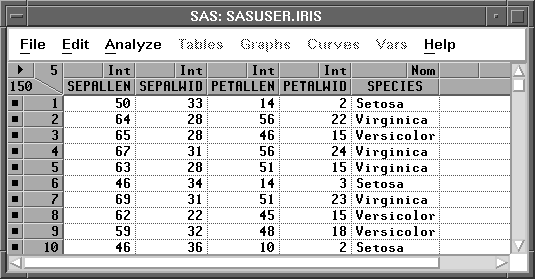Chapter Contents
Previous
Next
|
Chapter Contents |
Previous |
Next |
| Working with Other SAS Products |
The IRIS data, published by Fisher (1936), have been used widely for examples in discriminant analysis. The goal of the analysis is to find functions of a set of quantitative variables that best summarize the differences among groups of observations determined by the classification variable. The IRIS data contain four quantitative variables measured on 150 specimens of iris plants. These include sepal length (SEPALLEN), sepal width (SEPALWID), petal length (PETALLEN), and petal width (PETALWID). The classification variable, SPECIES, represents the species of iris from which the measurements were taken. There are three species in the data: Iris setosa, Iris versicolor, and Iris virginica.

Linear combinations of the four measurement variables best summarize the differences among the three species, assuming multivariate normality with covariance constant among groups. This requires a canonical discriminant analysis that is available in both SAS/INSIGHT software and SAS/STAT software. The following steps illustrate how to create an output data set that contains scores on the canonical variables in SAS/STAT software and how to use SAS/INSIGHT software to plot them.
| If you are running the SAS System in interactive line mode, exit the SAS System and reenter under the display manager. |
You must invoke SAS/INSIGHT software from
a command line or from the Solutions menu
to use SAS/INSIGHT software and the Program Editor concurrently.
| In the Program Editor, enter the statements shown in Figure 30.3. |

The OUT= option in the PROC DISCRIM statement puts the scores and the original variables in the SASUSER library in a data set called CAN_SCOR. For complete documentation on the DISCRIM procedure, refer to the chapter titled "The DISCRIM Procedure," in the SAS/STAT User's Guide.
| In the Program Editor, enter the statements in Figure 30.4. |
These statements create the _OBSTAT_ variable,
which stores observation colors, shapes, and other states.
If you create the _OBSTAT_ variable as shown,
SETOSA observations will be red triangles,
VERSICOLOR observations will be blue circles,
and VIRGINICA observations will be magenta squares.

_OBSTAT_ is a character variable. You can use it to set other observation states in addition to color and shape. The format of the _OBSTAT_ variable is as follows.
The _OBSTAT_ variable can be used to create color blends as well as discrete colors. For an example of this usage, refer to Robinson (1995).
| Choose Run:Submit to submit the SAS statements. |
This produces the PROC DISCRIM output shown in Figure 30.6 and creates the CAN_SCOR data set.

| Invoke SAS/INSIGHT software, and open the CAN_SCOR data set. |
| Scroll to the right to see the canonical variables CAN1, CAN2, and CAN3. |
These variables represent the linear combinations
of the four measurement variables that summarize
the differences among the three species.

By plotting the canonical variables, you can visualize how well the variables discriminate among the three groups. Canonical variables, having more discriminatory power, show more separation among the groups in their associated axes on a plot, while variables having little discriminatory power show little separation among groups.
| Choose Analyze:Rotating Plot ( Z Y X ). Assign CAN3 the Z role, CAN2 the Y role, and CAN1 the X role. |
This produces a plot with the CAN3 axis pointing toward you,
showing clear separation of the species.

| Click OK in the dialog to create the rotating plot. |

| Rotate the plot so the axis representing CAN1 points toward you. |
Refer to Chapter 6, "Exploring Data in Three Dimensions," for information on how to rotate
plots.
This orientation shows little, if any, differentiation among
species. This is because CAN2 and CAN3
contribute little information towards separating the groups.

Another way of illustrating this would be to create a scatter plot matrix of CAN1, CAN2, and CAN3. Only plots involving CAN1 would show much group differentiation. The CAN2-by-CAN3 plot would show little or no group differentiation.
Related Reading | Rotating Plots, Chapter 6, Chapter 37. |
|
Chapter Contents |
Previous |
Next |
Top |
Copyright © 1999 by SAS Institute Inc., Cary, NC, USA. All rights reserved.